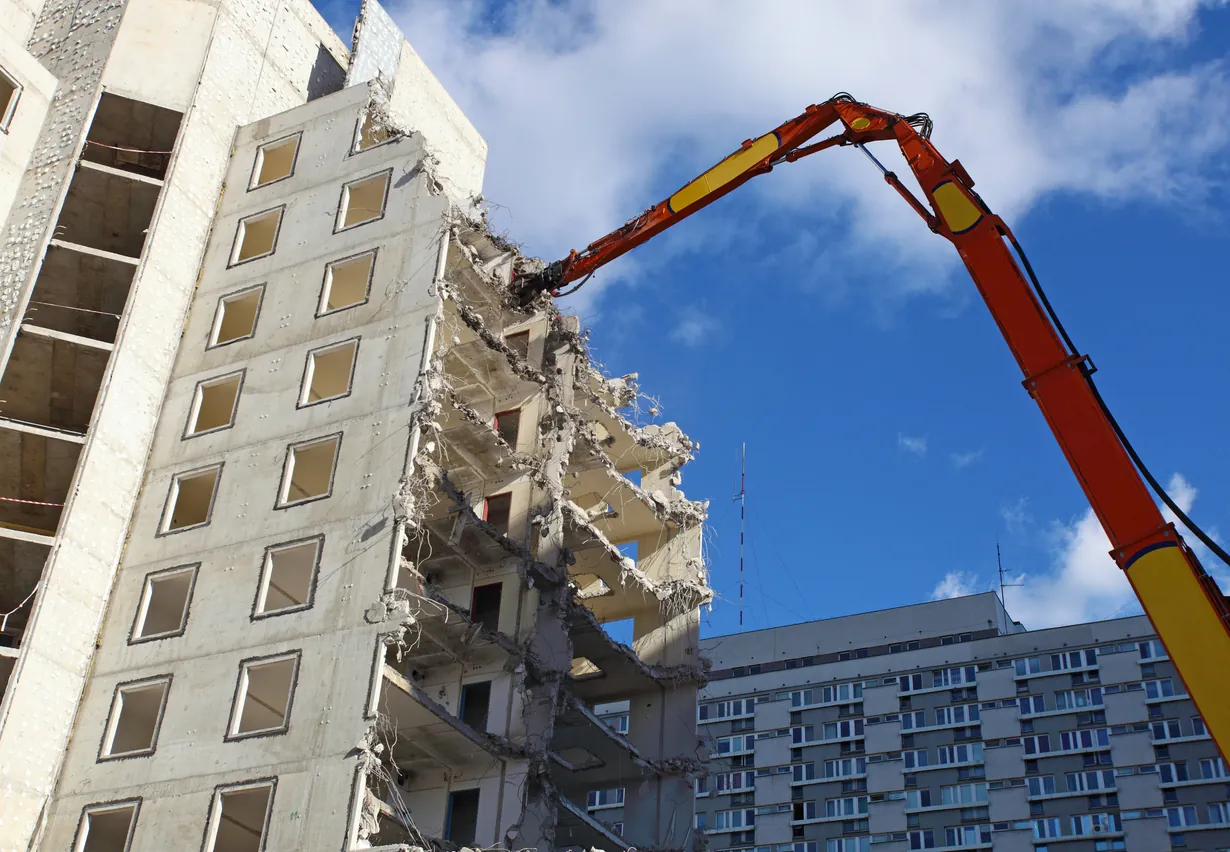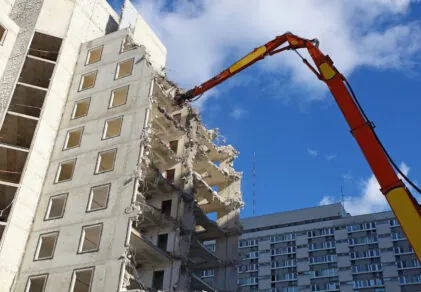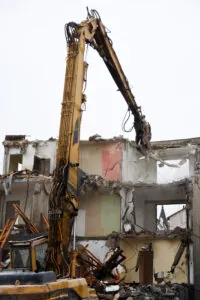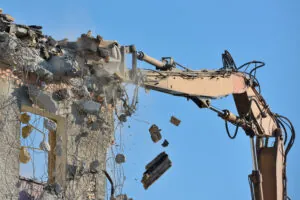Table of Contents
- 1 Methods of Demolition
- 2 Types of Demolition
- 3 Choosing the Right Attachments in High-Reach Demolition
- 4 Durable Hydraulic Quick Couplings Support High-Reach Demolition
- 5 Highway & Bridge Demolition
- 6 The Role of Hydraulic Connections in Demolition
- 7 Hydraulic Quick Connect Products Enhance Demolition Efficiency and Profitability
- 8 Stucchi’s Partnership with Demolition Contractors
- 9 Bridge Demolition Case Study
- 10 Improve Profit for Demolition Contractors
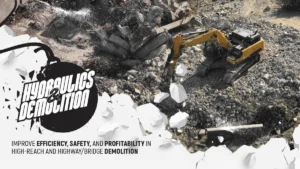
The demolition industry has undergone significant transformations, from manual wrecking ball methods to advanced hydraulic-powered techniques. Hydraulic systems are pivotal in modern demolition processes, ensuring safety, efficiency, and precision.
Maintaining reliable hydraulic connections with durable quick couplings that withstand heavy-duty processes under pressure is key to achieving maximum productivity and profitability.
Stucchi authored this featured article, first published in the April ’24 issue of Fluid Power Journal, sharing our knowledge of hydraulics & demolition.
(This onsite article features additional information: hydraulic products, solutions, real-world case studies, and complete guides to improving the efficiency, safety, and profitability in high-reach and bridge demolition applications)
Methods of Demolition
There are various methods of demolition and types of machinery and equipment used, depending on the type of demolition application. The primitive image of a wrecking ball may come to mind. However, popular from the 1930s to the 70s, this antiquated demolition method has been replaced with long-reach excavators and hydraulic attachments. Excavators and hydraulic fluid power bring greater efficiency, precision, and safety to modern demolition processes.
Mechanical demolition utilizes specialized equipment and tools, such as excavators with long booms and attachments designed to break down concrete and steel structures. Smaller equipment like skid steer loaders and demolition robots are used for more precise and selective demolition tasks.
Implosion is a highly specialized method that employs explosives to bring down tall structures by undermining their structural supports, causing the building to collapse within its footprint or along a predetermined path. Implosion is used in less than 1% of demolition projects due to its complexity and safety concerns.
Types of Demolition
There are many different types of demolition, such as commercial, industrial, interior, deconstruction, high-reach demolition, and demolition of highways and bridges. Deconstruction is a specialized type of demolition that is more labor-intensive and focused on preserving recyclable materials. High-reach demolition and demolition of bridges and highways require excavators with long booms and various attachments to demolish tall structures safely and precisely.
High-Reach Demolition
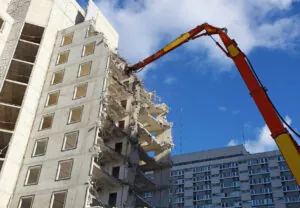 High-reach demolition is a specialized method for dismantling tall and structurally complex buildings, often 20 stories or more. These structures may consist of steel, masonry, and concrete, making traditional demolition methods impractical. High-reach demolition relies on high-reach excavators with long booms and specialized attachments to dismantle buildings from the top down. This approach ensures safety and precision, particularly when adjacent structures must remain intact.
High-reach demolition is a specialized method for dismantling tall and structurally complex buildings, often 20 stories or more. These structures may consist of steel, masonry, and concrete, making traditional demolition methods impractical. High-reach demolition relies on high-reach excavators with long booms and specialized attachments to dismantle buildings from the top down. This approach ensures safety and precision, particularly when adjacent structures must remain intact.
High-reach booms with specialized hydraulic attachments mounted on excavator platforms are designed to reach tall structures. High-reach booms allow for careful and controlled demolition, which is crucial in urban areas. This increases safe demolition processes.
High-reach booms with attachments contribute to the need for recycling and processing debris with efficiency and less labor than required years ago. Using multiple attachments on one mobile equipment base and quick-changing hydraulic attachments greatly increases efficiency and productivity.
With the right attachments and proper maintenance of auxiliary hydraulics, demolition contractors can achieve many benefits, including:
- Reduced time spent on-site
- Reduced costs
- Increased safety
- Increased recycling efforts
- Increased productivity
- Improved profitability
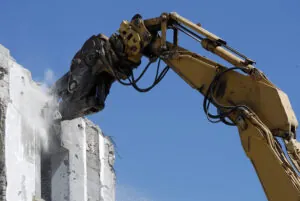 Choosing the Right Attachments in High-Reach Demolition
Choosing the Right Attachments in High-Reach Demolition
Demolition crews must have the appropriate attachment selection to perform various tasks common to many demolition sites. The application should be the first factor to guide an attachment choice. The choice depends on the type of material and how it must be broken up. An example would be primary to secondary demolition and rebar-enforced concrete compared to wood or brick structures.
When demolishing a structure, primary picks include multi-processors, shears, hydraulic breakers, demolition grapples, pulverizers, and crushers. Crusher and pulverizer attachments are the best for tackling jobs made mostly of concrete. For concrete structures, contractors will use multi-processors, hammers, and secondary pulverizers for primary and secondary demolition.
If concrete isn’t part of the demolition but steel is, a demolition processor with shear jaws or a mobile shear attachment is best practice. For heavy steel structure demolition, contractors often use demolition shears or a multi-processor with shear jaws to utilize scrap.
A hydraulic breaker is often a good choice for tackling rock or large-scale demolition projects. Many contractors use a demolition grapple when working with light materials such as wood and brick, commonly found in residential demolition.
Besides breaking apart materials, rotating grapples work well for sorting during secondary demolition and increase versatility and productivity by allowing a wide range of movement. Ultimately, the use of attachments serves the contractor in terms of efficiency and productivity.
Hydraulic Hammers, Shears, and Processors
- Hammers (Hydraulic Breakers): Hydraulic breakers, commonly known as hammers, are crucial and perhaps the most commonly used attachments on a demolition site. They quickly deliver high-breaking force to demolish concrete, pavement, and rock. These breakers are also used for trenching tasks. Hydraulic breakers are indispensable tools in high-reach demolition and other demolition processes.
They offer several advantages:
- High breaking force: Hydraulic breakers can power through materials quickly, making them essential for breaking concrete, pavement, and rock.
- Minimal maintenance: These breakers require minimal routine maintenance, ensuring cost-effectiveness and minimal downtime on the job.
- Adaptability: Hydraulic breakers can be used on various demolition equipment, from large excavators to mini-excavators and compact loaders.
- Improved technology: Innovations have led to hydraulic breakers providing 2 to 3 times more blows per minute (BPM), enhancing efficiency.
- Shears: Shears are used to cut through materials like steel and concrete. They can rotate 360 degrees for horizontal, vertical, and angled cuts, making them versatile tools for high-reach demolition projects.
- Processors: Processors are designed to break down materials into smaller pieces, such as gravel. They are vital in reducing debris size for easier disposal or recycling.
Durable Hydraulic Quick Couplings Support High-Reach Demolition
Hydraulics support high-reach demolition processes and must maintain a reliable fluid power supply when booms are extended to power attachments like hydraulic hammers and shears. The hydraulic system, including durable auxiliary hydraulic quick couplings, is crucial to maintaining the power required for these heavy-duty processes. Durable auxiliary hydraulic couplers are just as important during attachment changeovers and when operators must tear down the equipment to transport it.
Auxiliary hydraulic quick couplings must maintain their performance without premature wear, which can lead to unexpected equipment maintenance and unplanned downtime. Unexpected maintenance and downtime are profit killers in demolition jobs, which are always on a tight schedule.
Highway & Bridge Demolition
Demolishing highways and bridges requires meticulous planning and the use of specialized equipment. Unlike the stereotypical image of wrecking balls or explosives, highway and bridge demolition primarily rely on hydraulic excavators equipped with attachments for concrete removal and girder dismantling.
Engineering Analysis in Highway & Bridge Demolition
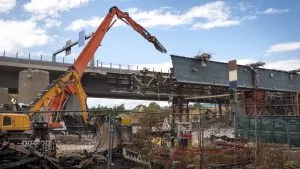 Demolishing structures like highway overpass bridges demands the same thorough engineering analysis as required during the construction phase. This analysis considers factors like excavator positions, demolition stages, excavator body weight, and the weight of hammer tips.
Demolishing structures like highway overpass bridges demands the same thorough engineering analysis as required during the construction phase. This analysis considers factors like excavator positions, demolition stages, excavator body weight, and the weight of hammer tips.
Additionally, engineering work is required for crane support design, pick plans, pick weights, and rigging design when cranes are used for demolition. Auxiliary quick couplings and multi-coupling plates support high-reach bridge demolition for safe and efficient processes and help crane operators quickly set up and tear down equipment for peak performance.
Equipment Used in Highway & Bridge Demolition
Highway and bridge demolition primarily relies on excavators and cranes, with the following tools:
- Excavators: Equipped with hydraulic hammers or shears, excavators are essential for concrete removal and girder dismantling.
- Hydraulic Hammers or Shears: These attachments are used to break concrete and remove sections of the structure.
- Cranes: Cranes are crucial in lifting and removing heavy structural components like girders.
The Role of Hydraulic Connections in Demolition
Hydraulic systems provide the power needed for modern demolition equipment to operate attachments and perform precise and controlled demolitions. In high-reach and highway/bridge demolition, hydraulic connections are a critical equipment component. These connections ensure the seamless flow of hydraulic fluid to power various attachments and perform the necessary tasks.
Operators must often switch between these attachments without jeopardizing hydraulic hoses, damaging couplers, or leaking fluid. This is where quality hydraulic connections and quick couplers come into play. High-quality, durable auxiliary hydraulic quick couplings prevent premature wear and damage, reducing maintenance, preventing downtime, and providing many advantages to demolition contractors.
Importance of Hydraulic Quick Couplers and Auxiliary Couplings
Hydraulics are the lifeblood of excavators used in demolition applications. Hydraulics power the connection and disconnection of attachments, replacing manual quick couplers to do the job effortlessly and in a fraction of the time. Where multiple attachments may be used on a single equipment base, the ability to switch between attachments rapidly is crucial to meeting deadlines and operating profitably.
This type of hydraulic quick coupler is different from hydraulic quick couplings, which connect hydraulic hoses; these quick couplings are referred to as auxiliary quick couplings in excavator applications, not to be confused with the quick coupler to connect and disconnect attachments.
Here are some key reasons why durable hydraulic quick couplers are vital in demolition:
- Increased Efficiency: Operators equipped with quality hydraulic quick couplers can switch between attachments in as little as one minute, compared to ten minutes or more with manual connections. This rapid attachment changeover significantly enhances efficiency.
- Support for Versatility: Demolition job sites often require various attachments to tackle different tasks efficiently. Hydraulic quick couplers support the versatility needed for excavator operators to switch between attachments confidently, making demolition operations more efficient and utilizing various tools on one equipment base.
- Improved Safety: Minimizing time outside the excavator cab enhances job site safety. Quick and efficient attachment changeover reduces the operator’s exposure to potentially hazardous hydraulic work tools, often heavy and under high pressure.
- Prevention of Contamination: Hydraulic fluid leaks pose risks to workers and the environment. Threaded, flat-face quick couplers, such as those designed by Stucchi, offer protection against fluid leaks and contamination of the hydraulic circuit.
Hydraulic quick couplings are also used to connect the fluid power hoses in the auxiliary hydraulic system that powers the attachments during use. Both hydraulic systems are critical to perform safe and efficient demolition work. The hydraulic system of excavators during demolition work is often under high pressure or experiences high-pressure impulses. It is important to use auxiliary hydraulic quick couplings designed to connect and disconnect under pressure easily and without fluid spillage.
Stucchi offers several quick couplings specifically designed to connect easily under pressure with no fluid leaks and offers a detailed video under the Resources section of our website on How to Connect and Disconnect Under Pressure. Learn more about Stucchi’s hydraulic solutions for the Demolition Industry.
Hydraulic Quick Connect Products Enhance Demolition Efficiency and Profitability
In the world of demolition, efficiency and precision are paramount. Several factors can significantly impact a project’s success and profitability, such as:
- The ability to quickly switch between various hydraulic attachments
- The ability to set up and tear down long booms and crane equipment quickly when equipment is experiencing pressure
- Making hydraulic connections with no fluid leaks
Stucchi, a leading manufacturer of hydraulic quick-connect products, understands these challenges and offers a range of solutions tailored to the demands of demolition applications.
The VEPHDL – Heavy Duty, Locking Threaded, Flat Face Coupler
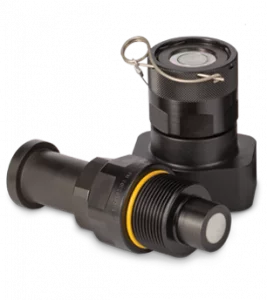 Stucchi’s VEPHDL is a heavy-duty, locking version of the VEP threaded flat-face coupler series, designed specifically for the most demanding hydraulic applications, including demolition processes. This durable quick coupler provides failsafe connections, even in the harshest conditions encountered during demolition work.
Stucchi’s VEPHDL is a heavy-duty, locking version of the VEP threaded flat-face coupler series, designed specifically for the most demanding hydraulic applications, including demolition processes. This durable quick coupler provides failsafe connections, even in the harshest conditions encountered during demolition work.
Key features of the VEPHDL include:
- Size range: Available from 3/4″ to 1 1/2″.
- Port options: NPT, SAE, and Code 62 Flange Ports to suit various hydraulic systems.
- Interchangeability: The VEPHDL seamlessly interchanges with VEPHD and VEP couplers, offering versatility.
- Pressure capabilities: It can connect and disconnect up to 25 MPa (3625 psi) of residual pressure.
- Working pressure: Operating within 40-50 MPa (5800-7975 psi).
- Locking mechanism: The VEPHDL features a locking heavy-duty series with a visual connection indicator, ensuring a secure, failsafe, leak-free connection.
The VEPHDL finds its ideal applications in the following:
- Demanding hydraulic environments with high pressure and high impulse conditions.
- Vibrations and torsional forces characterize heavy-duty applications.
- Mobile excavation and construction equipment such as backhoes, loaders, and excavators.
- Any situation where a failsafe connection is mission-critical.
- Demolition projects with demanding hydraulic requirements.
Matching the VEP with the appropriate plate size for your excavator or machine is crucial.
Multi-Coupling Plates: Elevating Safety and Efficiency
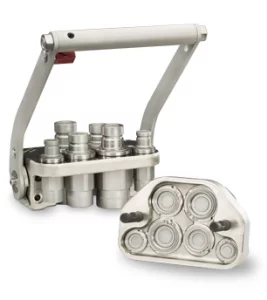 Multi-coupling plates are invaluable in hydraulic applications where multiple lines are in use. Stucchi offers the GR Series and DP Series of multi-coupling plates, each providing several advantages for quick connect and release operations across various equipment types, including mobile machinery and excavators.
Multi-coupling plates are invaluable in hydraulic applications where multiple lines are in use. Stucchi offers the GR Series and DP Series of multi-coupling plates, each providing several advantages for quick connect and release operations across various equipment types, including mobile machinery and excavators.
GR Plate Series highlights:
- Size range: Available in sizes from 3/8″ to 1 1/4″.
- Port options: NPT, SAE, and BSP ports ensure compatibility with various hydraulic systems.
- Pressure capabilities: Connects and disconnects under up to 25 MPa (300 bar/3625 psi) residual pressure.
- Simplicity: Simple single-motion connection and auto-lock design prevent accidental disconnection.
- Versatility: Accommodates 2 to 10 lines of different nominal size couplers or lines of the same size with varying media requirements.
The GR Series excels in applications requiring:
- Leak-free connections, whether residual pressure is present or not.
- Diverse equipment types, including harvesters, front-end loaders, snow removal, construction machinery, mining, and drilling equipment.
- Refrigeration equipment and other hydraulic systems.
DP Plate Series features:
- Size range: Available in sizes from 3/8″ to 1″.
- Port options: NPT, SAE, and BSP ports offer flexibility for different hydraulic setups.
- Pressure capabilities: Connects and disconnects up to 25 MPa (300 bar/3625 psi) residual pressure.
- Working pressure: Suitable for applications operating between 30-35 MPa (4350-5075 psi).
- Ease of use: Simple single-motion connection and auto-lock design enhance user experience.
- Line Compatibility: Accommodates 1 to 4 lines of the same nominal coupling size with varying media requirements.
The DP Plate Series is perfect for applications involving:
- Leak-free connections, whether residual pressure is present or not.
- Diverse equipment types, including harvesters, front-end loaders, snow removal, construction machinery, mining, and drilling equipment.
- Refrigeration equipment and other hydraulic systems.
Reliable Skid Steer Quick Couplers
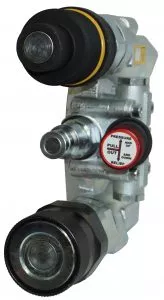 Stucchi also offers a wide selection of high-quality hydraulic quick couplers tailored for skid steer machines used across various applications, including earthmoving, agriculture, construction, and demolition. These quick couplers enhance operational efficiency and safety.
Stucchi also offers a wide selection of high-quality hydraulic quick couplers tailored for skid steer machines used across various applications, including earthmoving, agriculture, construction, and demolition. These quick couplers enhance operational efficiency and safety.
Notable options among Stucchi’s skid steer couplers include:
- Saturn Block: A direct field replacement for various pressurized connection systems, providing simple and user-friendly connection and disconnection with a built-in relief system. It is interchangeable with ISO 16028 products.
- A Premier Series: This flat-face ISO 16028 interchangeable coupling offers superior flow characteristics, lower pressure drop, and higher pressure ratings.
- A-HD: Specifically designed for addressing residual pressure in hydraulic circuits where pressure develops due to the thermal expansion of the trapped fluid. It allows for easy manual connection even under residual pressure conditions.
- APM Series: This quick-connect solution is designed to relieve pressure only within itself, making it ideal for applications where trapped fluid or thermal expansion can cause pressure buildup. It connects and disconnects by hand without any fluid leakage.
- VEP Series: A popular threaded flat-face coupler suitable for applications subjected to high-pressure impulses or those where residual pressure exists or is trapped in a line.
- VEPHD: The heavy-duty version of the VEP Series provides enhanced durability with higher-grade steel construction and QPQ plating.
- VEPHDL: Designed for leak-free connections in applications characterized by high pressure, pressurized impulses, and demanding processes with torsion and vibrations. The VEPHDL is particularly suitable for mobile construction equipment like skid steer machines, offering the quick connect solution essential in excavators, loaders, backhoes, and other mobile machinery. It is interchangeable with the VEP and VEPHD.
Stucchi’s Partnership with Demolition Contractors
Stucchi takes pride in collaborating closely with demolition contractors and equipment suppliers to ensure that their hydraulic quick couplers meet the specific demands of heavy-duty applications. Through comprehensive equipment and application evaluations, our hydraulic specialists provide reliable auxiliary quick couplers designed to excel in challenging environments.
Bridge Demolition Case Study
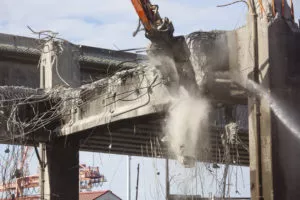 A notable Case Study showcases Stucchi’s successful partnership with a Bridge Demolition Contractor and can be found under the Resources, Case Study section of Stucchi’s website. The contractor faced the challenge of completing a bridge demolition project in downtown Denver within a tight 56-hour timeframe to avoid substantial fines for delays. The key highlights include:
A notable Case Study showcases Stucchi’s successful partnership with a Bridge Demolition Contractor and can be found under the Resources, Case Study section of Stucchi’s website. The contractor faced the challenge of completing a bridge demolition project in downtown Denver within a tight 56-hour timeframe to avoid substantial fines for delays. The key highlights include:
- Critical Time Constraints: The contractor had a limited window to complete the demolition due to the closure of the interstate, emphasizing the need for efficient equipment and hydraulic quick couplers.
- Profitability at Stake: Timely completion of the project was crucial to avoid a significant financial penalty. Profitability hinged on maximizing equipment uptime and preventing unforeseen setbacks.
- Equipment Interchangeability: The contractor rented additional equipment and required hydraulic quick couplers that seamlessly interchange between various attachments and machines.
VEPHDL Heavy-Duty Quick Coupler Solution: Stucchi’s quick coupling specialist collaborated closely with the client and equipment supplier to provide a comprehensive solution. The VEPHDL heavy-duty, threaded flat-face coupler was chosen for its reliability and interchangeability.
Successful Project Outcome: Through effective communication and coordination, the contractor completed the bridge demolition ahead of schedule, achieving revenue goals, and securing future projects with the Department of Transportation (DOT).
Benefits of VEPHDL Coupler: By utilizing Stucchi’s VEPHDL heavy-duty, locking quick coupler, the contractor realized several benefits, including early project completion, meeting revenue targets, and ensuring environmental and safety goals were met with leak-free performance.
Stucchi’s VEPHDL quick coupler was crucial in enabling the contractor to meet the demanding requirements of a time-sensitive demolition project, ultimately leading to increased profitability and future opportunities.
Improve Profit for Demolition Contractors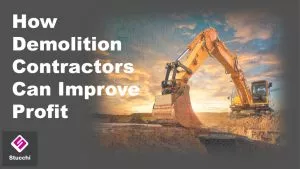
A more detailed description of all hydraulic solutions that impact the performance and profitability of demolition projects can be found in the Resources, Whitepaper section of Stucchi’s website: FREE Guide to Improve Profit for Demolition Contractors.
The guide covers essential aspects such as quick changeovers, interchangeability, leak-free auxiliary hydraulics, and reliable hydraulic connections.
Hydraulic fluid power gives demolition equipment the needed power, particularly for demanding, heavy-duty processes like high-reach and highway/bridge demolition projects. Be sure to contact us to speak with an experienced hydraulic quick-connect specialist to achieve maximum safety, efficiency, and productivity in demanding demolition applications.
this post first appeared here: Hydraulics & Demolition – Fluid Power Journal

